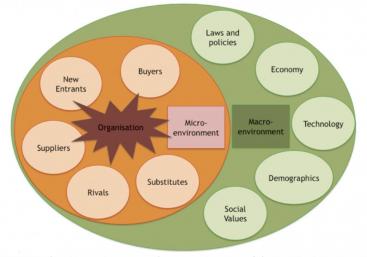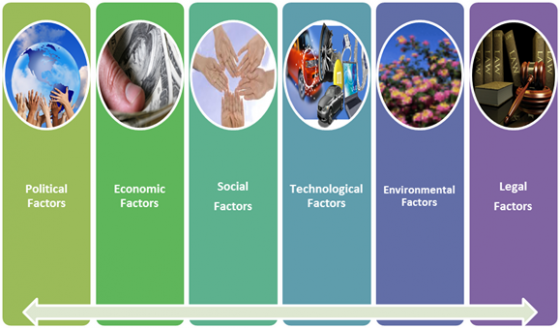Executive Summary
Environmental scanning is a term commonly used in management, and we feel sometimes overwhelmed with numbers of methodologies such as PESTLE, STEP, STEEP, PESTLE, LEPEST, STEEPLE, STEEPLED etc. that at the end are different ways of naming the same thing! But what is environmental scanning for? And how would it help you as an entrepreneur embarking in the water and sanitation sector? Environmental scanning is in fact a very important tool, because it will help you to better understand what is happening around you to capitalize external factors, trends, and emerging issues into successful business ideas. The tricky part is how to do it, because in a world like ours overloaded of information, it is very easy to get lost in tons of news, articles, blogs, links, videos, etc. Besides giving an introduction about the external factors affecting your start-up, this chapter will present a process to carry out an environmental scanning in the water and sanitation sector, presenting in the following sub-sections a compendium of factsheets that will guide you through different key factors in the external business environment of this dynamic sector.
The water and sanitation sector is a multidisciplinary field of work affected by multiple forces at the global, national and local level. As an entrepreneur, you need to look outside the premises of your start-up to take advantage of the emerging opportunities and to monitor and minimise the potential threats faced by your new business.
The business environment consists of various forces that affect your ability as a start-up to deliver products and services to your customers.

The Micro-environment and Macro-environment of the organisation
The internal business environment of your start-up consists of various forces in your immediate environment that affects your ability to operate effectively in your chosen markets. This includes your relationship with suppliers and distributors, the characteristics of your customers and the position of your competitors (the micro-environment).
What is the SSWM External Business Environment?
The external business environment consists of broader forces that not only affect your start-up, but also other actors in the micro-environment. These shape the characteristics of the opportunities and threats and are factors that are largely uncontrollable by you or any other company.
The environment can affect your start-up in dramatic ways. You can have the best business idea with a great technology but it might still fail miserably if factors like changes in the policies of the host government, new regulations or an economic crisis in the host country come along. Therefore, it is imperative that you keep a close watch over environmental factors that affect your start-up and prepare adequately to face the emerging challenges.
PESTEL analysis is a framework that allows the evaluation of the status of your start-up in relation to the external environment. It covers political, economic, social, technological, legal and environmental factors. Depending on which elements are included and the order used to list them out, it can also be referred to as STEP, STEEP, PESTEL, PESTLE or LEPEST. Recently it was even further extended to STEEPLE and STEEPLED, including education and demographics. The following sub-sections will give a deeper overview of how these elements could affect your start-up in the water and sanitation sector:

Factors included in the PESTEL analysis
What is Environmental Scanning?
“Environmental scanning is the acquisition and use of information about events, trends, and relationships in an organisation's external environment, the knowledge of which would assist management in planning the organisation's future course of action” (CHOO 2001).
The aim of scanning is to provide robust information related to the state-of the art, trends and emerging issues to enable you to build up a business plan with a long-term perspective. The knowledge gathered through environmental scanning will give you the basis to avoid reacting and putting out fires in the future of your start-up (adapted from CONWAY 2009).
How to do Environmental Scanning?
(Adapted from CONWAY 2012)
Part 1: Focus Your Scanning
Because we have limited time, energy and limited resources, always start your scanning with a focus. Deciding what to scan for will most likely be linked to those major drivers of change in the external environment that are likely to have an impact on your start-up. You should ask yourself the question, “What is happening in my environment that will affect the future of my start-up?” Through this analysis, you should be able to identify emerging issues, uncertainties and trends (and their driving forces –why is this happening?) that have important implications for your business. Remember that you should scan at different levels:
- what competitors are doing,
- what is happening in the industry and how your competitors might respond,
- what is happening more generally with industry and government policy, and
- the broader societal and global trends.
You might need to interview some specialists, participate in specialised on-line forums in water and sanitation, or discuss with your professors or with your colleagues to identify what could be the critical trends in the water and sanitation sector affecting your start-up.
Part 2: Who should scan?
We are continuously scanning the external environment, either consciously or sub-consciously, but in order to take advantage of the findings, we should count with a system to record them formally. Ideally, you should have a team of people that contribute to the scanning process, especially because it involves the perception, efforts and sharing from different minds. But in case you are starting up a business alone, make sure you remain open minded, curious and systematic, welcoming diversity and thinking out of the box.
Part 3: Starting to Scan
Start by setting up your classification system that lists out the categories you will use to classify and record what you are finding. You can use for instance the PESTEL framework (political, economic, social, technological and legal factors), which will give you an idea of what are you going to look for. At the end of the scanning it will help you to retrieve your findings easily.
Google is the most obvious resource to start looking for information with a few keywords. Remember that you already have a focus, and considering that you will obtain thousand of hits with this search-machine, you should always ask yourself, “is this piece of information relevant to my start-up?” Ideally Google will take you to specialised web pages in water and sanitation that will keep you informed about the trends in this sector. These include:
…among many others. Make sure you subscribe to E-mailing lists with news and participate actively in forums, such as the www.ecosanres.org and forum.susana.org. There are also many regional groups that will keep you updated with the latest information in your country, for instance:
...among many others.
You should also review the local as well as international newspapers, as global news about economy, politics, regulations, etc. will be first published there! Don’t forget to keep an eye on seminars, conferences, expos and workshops happening near your locality. It is in the frame of these events that you will have the chance to listen about new technologies and approaches, and will help you to talk to experts during the coffee breaks.
Part 4: Recording Your Hits
You need to keep a track of your scanning hits to make use of this information in the future. How to do it would depend on your preferences. The options are manifold: word, excel, bookmarks, a simple notebook, or even specialised web-machines such as http://shapingtomorrow.com/. Once you have been scanning regularly for a couple of months, you will find that some hits will start showing some similarities. When this happens, you are starting to identify a trend! Try to dig out to learn more about it.
Part 5: Analysing Your Scanning Output
“At this stage, you have started to identify trends and you can see some interdependencies among those trends. What does it all mean? When you ask that question, it's time to move to analysis” (CONWAY 2012).
In order to evaluate how the current affairs, emerging issues and trends could affect the future of your start-up, you could make use of the External Factor Analysis Summary (EFAS). This tool indicates whether the company is able to effectively take advantage of existing opportunities along with minimising the external threats.
The first step you should take is to decide whether a particular trend is an opportunity or a threat for your start up. After this is done, follow these steps (Adapted from PU 2002):
- List opportunities & threats (5-10 each) in column 1.
- Weight each factor from 1.0 (Most Important) to 0.0 (Not Important) in column 2 based on that factor’s probable impact on the company’s strategic position. The total weights must sum to 1.00.
- Rate each factor from 5 (Outstanding) to 1 (Poor) in column 3 based on the company’s response to that factor.
- Multiply each factor’s weight times its rating to obtain each factor’s weighted score in column 4.
- Use column 5 (comments) for rationale used for each factor.
- Add the weighted scores to obtain the total weighted score for the company in column 4. This tells how well the company is responding to the strategic factors in its external environment.
The better positioned your start-up is, the higher the rating will be. For instance, 3 will indicate neither well nor poorly positioned, just average. A number higher than 3 will mean that the business is responding well to the external factors. A start-up with an overall rating of 5 would be responding to the respective environment in an outstanding way.
The following table presents a External Factors Analysis Summary (EFAS) for a company in India which designs and installs wastewater treatment plants:
| External Factors | Weight | Rating | Weighted Score | Comments | Priority in Actions to be Taken |
| Opportunities | |||||
| Launching of the National Urban Saniation Policy | 0.2 | 3 | 0.6 | We need to participate in more events of the NUSP and build up a network | 3 |
| Many Action Plans at State Level include green technologies | 0.1 | 4 | 0.4 | Our technologies are completely green, we need a clearer promotion plan | 4 |
| Water prices are increasing in India | 0.05 | 2 | 0.1 | We have not included an economic evaluation of the project including savings | 2 |
| Growing environmental awareness | 0.05 | 3 | 0.15 | We have been reacting to already aware potential costumers, we should play more the "environment card" | |
| New periurban areas not served by sewer systems and water supply | 0.2 | 5 | 1 | We are working well with building companies, providing sanitation services in remote areas | |
| Threats | |||||
| People do not accept the reuse of wastewater for any purpose | 0.1 | 4 | 0.4 | We have still managed to install reuse systems in gardens and green areas | 5 |
| Other compact systems are reaching the market | 0.1 | 1 | 0.1 | We need to offer new types of system that occupy less space | 1 |
| Construction groups are now in partnership with big players of the water sector | 0.05 | 5 | 0.25 | Even though we are not big, we are managing to enter into partnership with constructing companies | |
| The law is not enforced and therefore there is not need to invest on sanitation | 0.05 | 5 | 0.25 | We have targeted environmental conscious clients | |
| Most of the business is done with local governments, which tend to delay the payments | 0.1 | 5 | 0.5 | We have developed a payment system that facilitate our payments | |
| 1 | 3.75 |
Table: External Factors Analysis Summary for an Indian Company providing sanitation services
Part 6: Reporting your findings
Scanning improves an organisation’s abilities to deal with a rapidly changing environment in a number of ways:
- It helps an organisation capitalise on early opportunities rather than lose these to competitors.
- It provides an early signal of impending problems, which can be defused if recognised well in advance.
- It sensitises an organisation to the changing needs and wishes of its customers.
- It provides a base of objective qualitative information about the environment that strategists can utilise.
- It provides intellectual stimulation to strategists in their decision-making.
- It improves the image of the organisation with its public by showing that it is sensitive to its environment and responsive to it.
- It is a means of continuing broad-based education for executives, especially for strategy developers.
Environmental scanning as information seeking and organisational learning
Environmental Scanning… what it is and how to do it
Doing Environmental Scanning
This guide provides you with an overview of doing environmental scanning in your organisation. The aim is to allow you to build an understanding of the environmental scanning process and what is involved.
CONWAY, M. (2009): Doing Environmental Scanning. An Overview Guide. Hotham Hill, Australia: Thinking Futures URL [Accessed: 22.08.2012]Environmental scanning
This web article contains a thorough list of references regarding environmental scanning, as well as concepts and theories developed in the last decades. It also contains an interesting analysis of the external environment of Higher Education, which could be used for those planning starting up a business in the training sector of water and sanitation.
MORRISON, J.L. (1992): Environmental scanning. In: WHITELY, M.A. ; PORTER, J.D. ; FENSKE, R.H. (1992): A primer for new institutional researchers. Tallahassee, Florida: 86-99. URL [Accessed: 22.08.2012]Completing the External Factor Analysis Summary (EFAS) Form
Doing Environmental Scanning
This guide provides you with an overview of doing environmental scanning in your organisation. The aim is to allow you to build an understanding of the environmental scanning process and what is involved.
CONWAY, M. (2009): Doing Environmental Scanning. An Overview Guide. Hotham Hill, Australia: Thinking Futures URL [Accessed: 22.08.2012]Environmental scanning
This web article contains a thorough list of references regarding environmental scanning, as well as concepts and theories developed in the last decades. It also contains an interesting analysis of the external environment of Higher Education, which could be used for those planning starting up a business in the training sector of water and sanitation.
MORRISON, J.L. (1992): Environmental scanning. In: WHITELY, M.A. ; PORTER, J.D. ; FENSKE, R.H. (1992): A primer for new institutional researchers. Tallahassee, Florida: 86-99. URL [Accessed: 22.08.2012]The Environmental Scan: Identifying and classifying (external) factors
This document presents a methodology of how to scan the environment to identify the external factors that can affect the implementation of a project in Nepal.
TACSO (n.y): The Environmental Scan: Identifying and classifying (external) factors. Module 08 of the CSO Management Course. Sarajevo: Technical Assistance for Civil Society Organisations (TACSO) URL [Accessed: 08.10.2012]Strategic Planning
This document presents a study case of how to carry out an “External Factor Analysis Summary” by evaluating the societal and industry environment of the production of agricultural products.
DOBBINS, C. (n.y): Strategic Planning. External Environmental Scanning. West Lafayette: Purdue University URL [Accessed: 08.10.2012]Report on Environmental Scan of Water Sector in the Northern Region of Ghana
This document presents a deep study carried out in the Northern Region of Ghana to understand the water service delivery environment before the starting of a project to improve the rural water sector.
TRIPLE-S (2011): Report on Environmental Scan of Water Sector in the Northern Region of Ghana. The Hague: Triple-S URL [Accessed: 22.08.2012]http://www.thinkingfutures.net
This site presents valuable tools on how to carry out an environmental scanning in an effective manner. Furthermore, it offers resources to redesign the strategy of a company by changing the way of thinking about the future.
http://www.jiscinfonet.ac.uk
This online infoKit presents a wealth of tools for the implementation of effective strategic planning and managing of information, including environmental scanning.
http://horizon.unc.edu
This is a web page that details techniques and considerations that should be taken into account for environmental scanning, as well as a list of resources where more information about environmental scanning can be found.
www.youtube.com
A 5-minute video that gives you an idea of the competitiveness of a country based on the human capital, creating individual opportunities and economic prosperity.
www.youtube.com
This video presents the vision of the company Telefonica I+D of how the world will be in 2020 considering the economic, demographic and technological aspects.
www.youtube.com
A short animation looking at the technological and social changes that have happened in recent years, each change affects the way we interact not only with each other but the world in which we live... how do you survive and adapt?



